Wenji Mao
Think on your Feet: Adaptive Thinking via Reinforcement Learning for Social Agents
May 04, 2025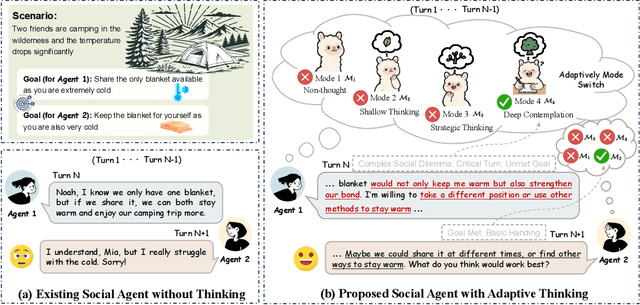
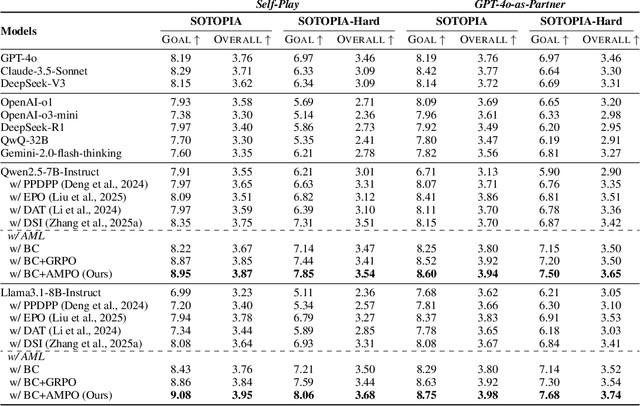
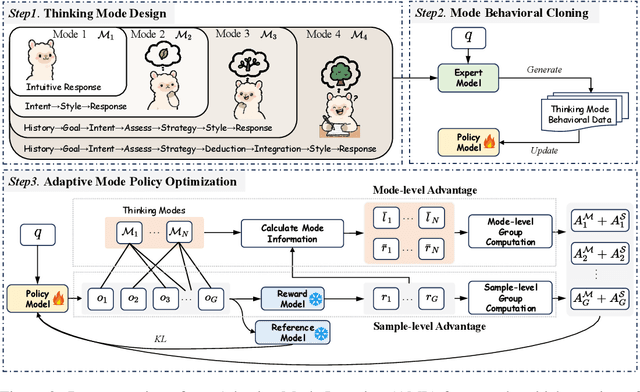
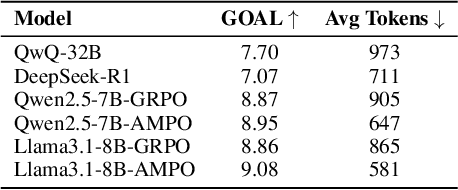
Abstract:Effective social intelligence simulation requires language agents to dynamically adjust reasoning depth, a capability notably absent in current approaches. While existing methods either lack this kind of reasoning capability or enforce uniform long chain-of-thought reasoning across all scenarios, resulting in excessive token usage and inappropriate social simulation. In this paper, we propose $\textbf{A}$daptive $\textbf{M}$ode $\textbf{L}$earning ($\textbf{AML}$) that strategically selects from four thinking modes (intuitive reaction $\rightarrow$ deep contemplation) based on real-time context. Our framework's core innovation, the $\textbf{A}$daptive $\textbf{M}$ode $\textbf{P}$olicy $\textbf{O}$ptimization ($\textbf{AMPO}$) algorithm, introduces three key advancements over existing methods: (1) Multi-granular thinking mode design, (2) Context-aware mode switching across social interaction, and (3) Token-efficient reasoning via depth-adaptive processing. Extensive experiments on social intelligence tasks confirm that AML achieves 15.6% higher task performance than state-of-the-art methods. Notably, our method outperforms GRPO by 7.0% with 32.8% shorter reasoning chains. These results demonstrate that context-sensitive thinking mode selection, as implemented in AMPO, enables more human-like adaptive reasoning than GRPO's fixed-depth approach
DEMO: Reframing Dialogue Interaction with Fine-grained Element Modeling
Dec 06, 2024



Abstract:Large language models (LLMs) have made dialogue one of the central modes of human-machine interaction, leading to the accumulation of vast amounts of conversation logs and increasing demand for dialogue generation. A conversational life-cycle spans from the Prelude through the Interlocution to the Epilogue, encompassing various elements. Despite the existence of numerous dialogue-related studies, there is a lack of benchmarks that encompass comprehensive dialogue elements, hindering precise modeling and systematic evaluation. To bridge this gap, we introduce an innovative research task $\textbf{D}$ialogue $\textbf{E}$lement $\textbf{MO}$deling, including $\textit{Element Awareness}$ and $\textit{Dialogue Agent Interaction}$, and propose a novel benchmark, $\textbf{DEMO}$, designed for a comprehensive dialogue modeling and assessment. Inspired by imitation learning, we further build the agent which possesses the adept ability to model dialogue elements based on the DEMO benchmark. Extensive experiments indicate that existing LLMs still exhibit considerable potential for enhancement, and our DEMO agent has superior performance in both in-domain and out-of-domain tasks.
Variational Graph Auto-Encoder Based Inductive Learning Method for Semi-Supervised Classification
Mar 26, 2024

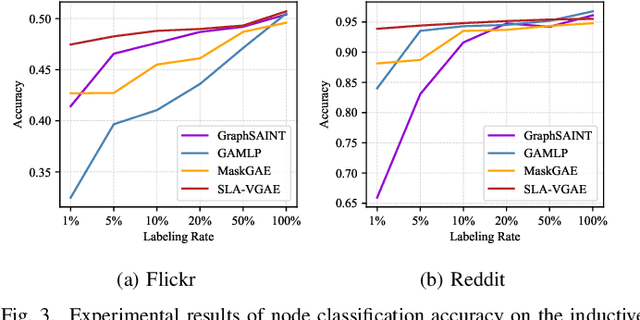
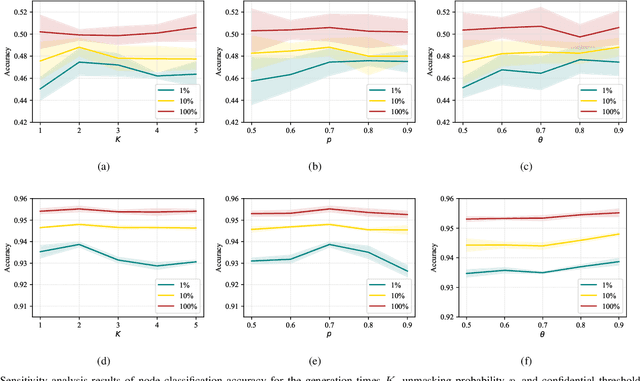
Abstract:Graph representation learning is a fundamental research issue in various domains of applications, of which the inductive learning problem is particularly challenging as it requires models to generalize to unseen graph structures during inference. In recent years, graph neural networks (GNNs) have emerged as powerful graph models for inductive learning tasks such as node classification, whereas they typically heavily rely on the annotated nodes under a fully supervised training setting. Compared with the GNN-based methods, variational graph auto-encoders (VGAEs) are known to be more generalizable to capture the internal structural information of graphs independent of node labels and have achieved prominent performance on multiple unsupervised learning tasks. However, so far there is still a lack of work focusing on leveraging the VGAE framework for inductive learning, due to the difficulties in training the model in a supervised manner and avoiding over-fitting the proximity information of graphs. To solve these problems and improve the model performance of VGAEs for inductive graph representation learning, in this work, we propose the Self-Label Augmented VGAE model. To leverage the label information for training, our model takes node labels as one-hot encoded inputs and then performs label reconstruction in model training. To overcome the scarcity problem of node labels for semi-supervised settings, we further propose the Self-Label Augmentation Method (SLAM), which uses pseudo labels generated by our model with a node-wise masking approach to enhance the label information. Experiments on benchmark inductive learning graph datasets verify that our proposed model archives promising results on node classification with particular superiority under semi-supervised learning settings.
YAYI-UIE: A Chat-Enhanced Instruction Tuning Framework for Universal Information Extraction
Jan 08, 2024Abstract:The difficulty of the information extraction task lies in dealing with the task-specific label schemas and heterogeneous data structures. Recent work has proposed methods based on large language models to uniformly model different information extraction tasks. However, these existing methods are deficient in their information extraction capabilities for Chinese languages other than English. In this paper, we propose an end-to-end chat-enhanced instruction tuning framework for universal information extraction (YAYI-UIE), which supports both Chinese and English. Specifically, we utilize dialogue data and information extraction data to enhance the information extraction performance jointly. Experimental results show that our proposed framework achieves state-of-the-art performance on Chinese datasets while also achieving comparable performance on English datasets under both supervised settings and zero-shot settings.
YAYI 2: Multilingual Open-Source Large Language Models
Dec 22, 2023Abstract:As the latest advancements in natural language processing, large language models (LLMs) have achieved human-level language understanding and generation abilities in many real-world tasks, and even have been regarded as a potential path to the artificial general intelligence. To better facilitate research on LLMs, many open-source LLMs, such as Llama 2 and Falcon, have recently been proposed and gained comparable performances to proprietary models. However, these models are primarily designed for English scenarios and exhibit poor performances in Chinese contexts. In this technical report, we propose YAYI 2, including both base and chat models, with 30 billion parameters. YAYI 2 is pre-trained from scratch on a multilingual corpus which contains 2.65 trillion tokens filtered by our pre-training data processing pipeline. The base model is aligned with human values through supervised fine-tuning with millions of instructions and reinforcement learning from human feedback. Extensive experiments on multiple benchmarks, such as MMLU and CMMLU, consistently demonstrate that the proposed YAYI 2 outperforms other similar sized open-source models.
Isomorphic-Consistent Variational Graph Auto-Encoders for Multi-Level Graph Representation Learning
Dec 09, 2023Abstract:Graph representation learning is a fundamental research theme and can be generalized to benefit multiple downstream tasks from the node and link levels to the higher graph level. In practice, it is desirable to develop task-agnostic general graph representation learning methods that are typically trained in an unsupervised manner. Related research reveals that the power of graph representation learning methods depends on whether they can differentiate distinct graph structures as different embeddings and map isomorphic graphs to consistent embeddings (i.e., the isomorphic consistency of graph models). However, for task-agnostic general graph representation learning, existing unsupervised graph models, represented by the variational graph auto-encoders (VGAEs), can only keep the isomorphic consistency within the subgraphs of 1-hop neighborhoods and thus usually manifest inferior performance on the more difficult higher-level tasks. To overcome the limitations of existing unsupervised methods, in this paper, we propose the Isomorphic-Consistent VGAE (IsoC-VGAE) for multi-level task-agnostic graph representation learning. We first devise a decoding scheme to provide a theoretical guarantee of keeping the isomorphic consistency under the settings of unsupervised learning. We then propose the Inverse Graph Neural Network (Inv-GNN) decoder as its intuitive realization, which trains the model via reconstructing the GNN node embeddings with multi-hop neighborhood information, so as to maintain the high-order isomorphic consistency within the VGAE framework. We conduct extensive experiments on the representative graph learning tasks at different levels, including node classification, link prediction and graph classification, and the results verify that our proposed model generally outperforms both the state-of-the-art unsupervised methods and representative supervised methods.
Disentangled Text Representation Learning with Information-Theoretic Perspective for Adversarial Robustness
Oct 26, 2022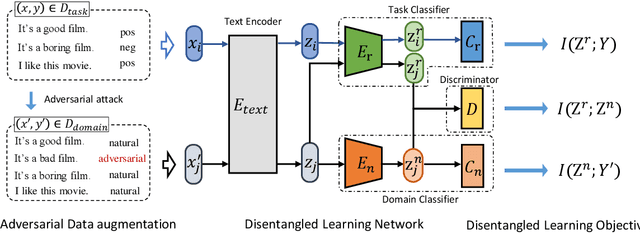



Abstract:Adversarial vulnerability remains a major obstacle to constructing reliable NLP systems. When imperceptible perturbations are added to raw input text, the performance of a deep learning model may drop dramatically under attacks. Recent work argues the adversarial vulnerability of the model is caused by the non-robust features in supervised training. Thus in this paper, we tackle the adversarial robustness challenge from the view of disentangled representation learning, which is able to explicitly disentangle robust and non-robust features in text. Specifically, inspired by the variation of information (VI) in information theory, we derive a disentangled learning objective composed of mutual information to represent both the semantic representativeness of latent embeddings and differentiation of robust and non-robust features. On the basis of this, we design a disentangled learning network to estimate these mutual information. Experiments on text classification and entailment tasks show that our method significantly outperforms the representative methods under adversarial attacks, indicating that discarding non-robust features is critical for improving adversarial robustness.
Spiking Variational Graph Auto-Encoders for Efficient Graph Representation Learning
Oct 24, 2022



Abstract:Graph representation learning is a fundamental research issue and benefits a wide range of applications on graph-structured data. Conventional artificial neural network-based methods such as graph neural networks (GNNs) and variational graph auto-encoders (VGAEs) have achieved promising results in learning on graphs, but they suffer from extremely high energy consumption during training and inference stages. Inspired by the bio-fidelity and energy-efficiency of spiking neural networks (SNNs), recent methods attempt to adapt GNNs to the SNN framework by substituting spiking neurons for the activation functions. However, existing SNN-based GNN methods cannot be applied to the more general multi-node representation learning problem represented by link prediction. Moreover, these methods did not fully exploit the bio-fidelity of SNNs, as they still require costly multiply-accumulate (MAC) operations, which severely harm the energy efficiency. To address the above issues and improve energy efficiency, in this paper, we propose an SNN-based deep generative method, namely the Spiking Variational Graph Auto-Encoders (S-VGAE) for efficient graph representation learning. To deal with the multi-node problem, we propose a probabilistic decoder that generates binary latent variables as spiking node representations and reconstructs graphs via the weighted inner product. To avoid the MAC operations for energy efficiency, we further decouple the propagation and transformation layers of conventional GNN aggregators. We conduct link prediction experiments on multiple benchmark graph datasets, and the results demonstrate that our model consumes significantly lower energy with the performances superior or comparable to other ANN- and SNN-based methods for graph representation learning.
A Comprehensive Empirical Study of Vision-Language Pre-trained Model for Supervised Cross-Modal Retrieval
Jan 08, 2022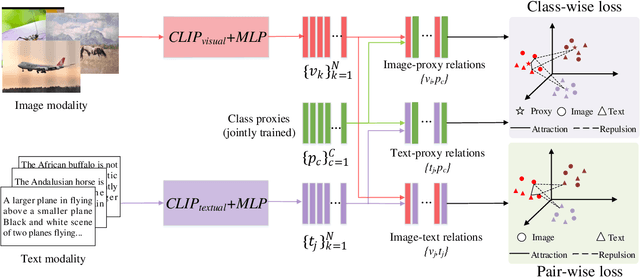
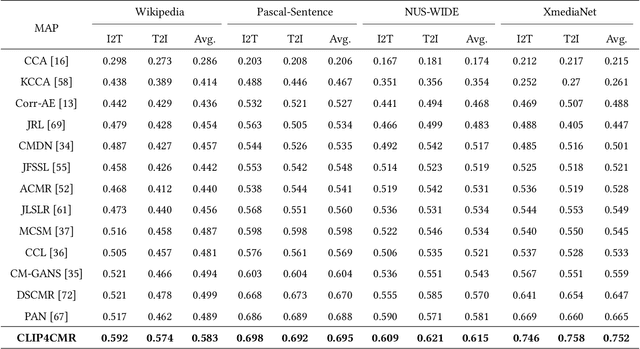
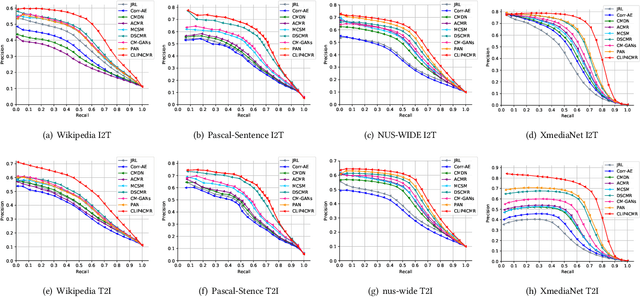

Abstract:Cross-Modal Retrieval (CMR) is an important research topic across multimodal computing and information retrieval, which takes one type of data as the query to retrieve relevant data of another type, and has been widely used in many real-world applications. Recently, the vision-language pre-trained model represented by CLIP has demonstrated its superiority of learning visual and textual representations and its impressive performance on various vision and language related tasks. Although CLIP as well as the previous pre-trained models have shown great performance improvement in unsupervised CMR, the performance and impact of these pre-trained models on supervised CMR were rarely explored due to the lack of multimodal class-level associations. In this paper, we take CLIP as the current representative vision-language pre-trained model to conduct a comprehensive empirical study and provide insights on its performance and impact on supervised CMR. To this end, we first propose a novel model CLIP4CMR (\textbf{CLIP For} supervised \textbf{C}ross-\textbf{M}odal \textbf{R}etrieval) that employs pre-trained CLIP as backbone network to perform supervised CMR. We then revisit the existing loss function design in CMR, including the most common pair-wise losses, class-wise losses and hybrid ones, and provide insights on applying CLIP. Moreover, we investigate several concerned issues in supervised CMR and provide new perspectives for this field via CLIP4CMR, including the robustness to modality imbalance and the sensitivity to hyper-parameters. Extensive experimental results show that the CLIP4CMR achieves SOTA results with significant improvements on the benchmark datasets Wikipedia, NUS-WIDE, Pascal-Sentence and XmediaNet. Our data and codes are publicly available at https://github.com/zhixiongz/CLIP4CMR.
AnANet: Modeling Association and Alignment for Cross-modal Correlation Classification
Sep 02, 2021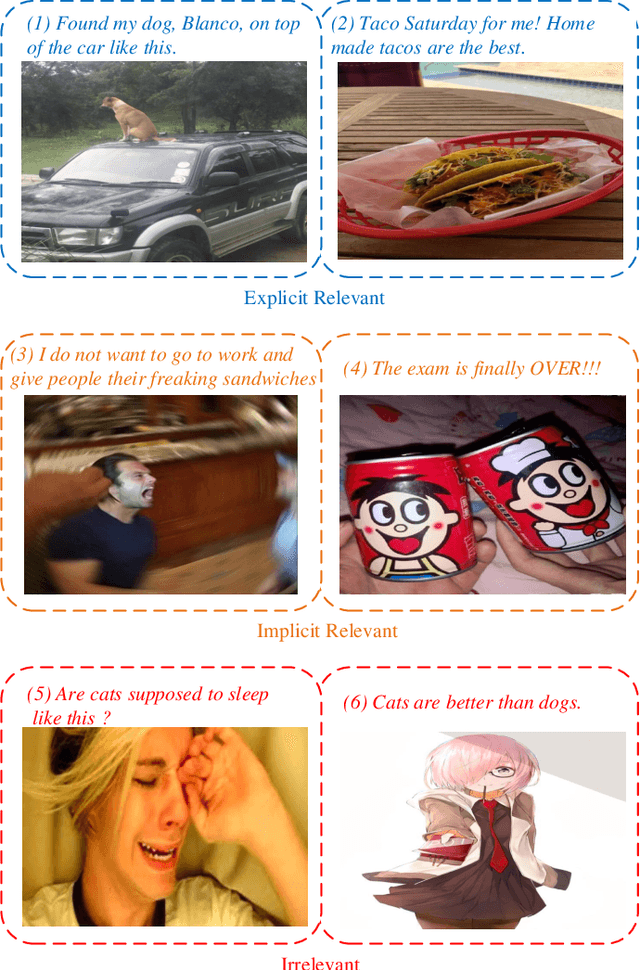
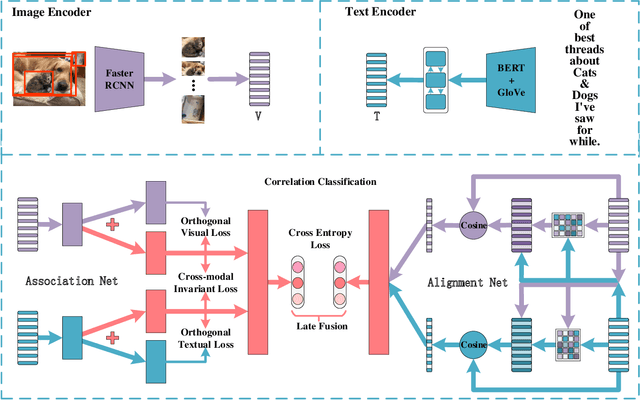

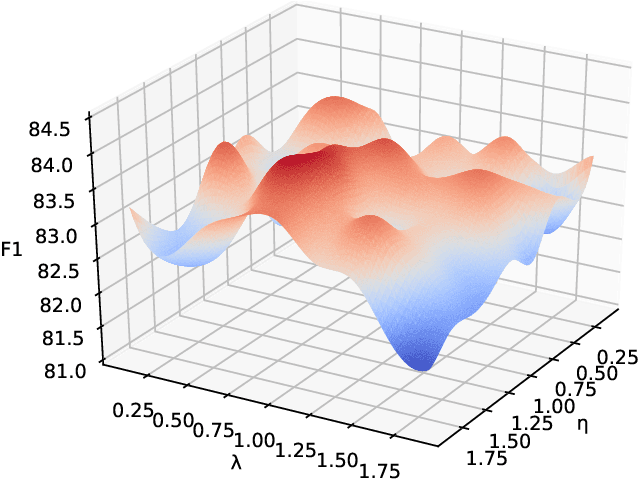
Abstract:The explosive increase of multimodal data makes a great demand in many cross-modal applications that follow the strict prior related assumption. Thus researchers study the definition of cross-modal correlation category and construct various classification systems and predictive models. However, those systems pay more attention to the fine-grained relevant types of cross-modal correlation, ignoring lots of implicit relevant data which are often divided into irrelevant types. What's worse is that none of previous predictive models manifest the essence of cross-modal correlation according to their definition at the modeling stage. In this paper, we present a comprehensive analysis of the image-text correlation and redefine a new classification system based on implicit association and explicit alignment. To predict the type of image-text correlation, we propose the Association and Alignment Network according to our proposed definition (namely AnANet) which implicitly represents the global discrepancy and commonality between image and text and explicitly captures the cross-modal local relevance. The experimental results on our constructed new image-text correlation dataset show the effectiveness of our model.
 Add to Chrome
Add to Chrome Add to Firefox
Add to Firefox Add to Edge
Add to Edge